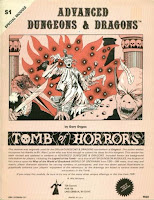This is the second post on the Tomb of Horrors. The first can be found
HERE.
I know it's a day late, and I'm sorry for that. I was surprised at how busy I was with the first 12 hours of the new
Kickstarter: Creeping Cold. Now that the obligatory link is out of the way, let's dive back into the Tomb of Horrors. (And again, this blog is full of SPOILERS.)
Backtracking to the Arch of Mist: I mentioned that this can separate parties. It sends incorrect guesses back to the beginning of the module. Following the correct path leads to a puzzle: "The Three Armed Statue." The puzzle has PCs destroy gems in 4 batches.
Destroying these gems once (3 total gems), twice (6 total gems), or thrice (9 total gems) causes nothing to happen. The 10th gem triggers a
Magic Mouth telling the PCs that they have gained something.
So far, I actually like the puzzle. An
INVISIBLE Gem of Seeing (really, invisible? after 1000 gp of gems were destroyed? Seems a little much) appears in the severed fourth hand. And the Gem is "immune" to
See Invisibility. If the "arm is carelessly moved, the gem will fall off and roll away."
Chances are the arm was carelessly moved before the Gem even appeared. And, the final part of the puzzle? The way out is a crawl-way, covered in illusion to look like the wall around it.
 |
| Image of Hall of Great Spheres from ToH |
Following the passage from the "Three Armed Statue" leads to a room. (Great Hall of Spheres) with a couple of traps, including the 2nd most famous (the Magic Archway). There are 20 spheres here in the walls and glyphs. Two false doors and the Magic Archway are the only noticeable exits.
The nearest trap to the Three Armed Statue is a false door. Every time the door is opened, a spear shoots out at a PC, forcing a Save vs Magic to avoid 2d8 damage. (My module only lists 1 of the doors as a trap. Other sources list both.) I am a fan of the false door trap. They are always unexpected (even here) and make for a fun jump-scare. Just don't over-use them!
Besides the Magic Archway, there are actually 3 exits from this room: the way to the Three Armed Statue, a door that needs a spell to open (
Knock, Disintegrate, Rock to Mud, or
Stone to Flesh), and another crawl-way that is covered with an illusion.
The Magic Archway is what dominates the room, though. As I mentioned previously, this is the 2nd most famous trap in Tomb of Horrors. It looks very similar to the Arch of Mist, but the colors are different. No messing with the stones changes what it looks like through the archway. Any character that goes through the archway is teleported back to the beginning of the dungeon. All of their equipment is teleported to the final boss.
Again, this trap sucks. It's an obvious way to advance. But, it steals your stuff instead. In a tournament or convention game, I would simply re-write it. In a tournament, I would have it take all treasure found within the Tomb and then send them back to the beginning. In a convention game, I would simply have it send them back to the beginning. In a home game, where the PCs can retreat, regroup and try again, I think it is a worthy challenge, and I would leave it alone.
 |
| Three Chests from ToH |
Moving on to the last room of the day, The Chamber of the 3 Chests. This is another room hidden by an illusion (and again a crawl space). As the name implies, this room has 3 chests within: "gold," "silver" and wood. Both the precious metals are simply plating over iron (and worth less than their weight).
All three of the chests are trapped. The gold chest houses 12 (3 HD) asps. For the sake of verisimilitude I will assume the snakes were in a form of stasis (but, the chest is non-magical). They are venomous, and saves are made at -2. But, I am unsure what the poison does. I guess that it would be the same as a Poisonous Snake from the Monster Manual (3d6 damage).
So, I have a couple of problems with this trap. I mentioned both above. 1st, how do the snakes stay alive? It just feels like sloppy writing on Gygax's part. 2nd, the stats aren't clear on what they actually do.
The second chest is silver, and actually has treasure within: a 1,000 gp crystal case containing a Ring of Protection +1. Removing the crystal case causes 8 darts to shoot upwards, automatically hitting 1-2 PCs with 4 each. Each dart does a d6 damage with no Save or attack roll.
I like this trap. It's not specified in the notes of ways to avoid it, so creative players can find solutions. There is no warning for the trap, however. But, in ToH everyone should assume everything is trapped.
The final chest teleports an "animated statue of a giant" into it as the chest is opened. The skeleton gets 2 attacks/rd (2d6), edged weapons only do 1 damage (no surprise there) and it is immune to magic (and turning).
Overall, the wooden chest trap is unimaginative and I would have liked the skeleton in the gold chest. A different type of trap could have been better here. (As an aside, what happens when both monster chests are opened? Do the skeleton and snakes randomly attack each other?) I would like to see a trap that paralyzes a party member (permanently until removed/dispelled) or a ceiling collapsing trap. Something other than the same thing twice.
So at the end of four rooms, we have 13 traps. Tomb of Horrors is living up to its reputation.
























